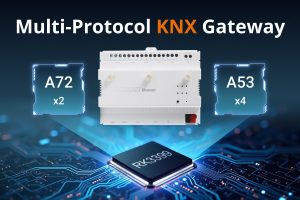1. Introduction of DSM-04B Zigbee/Matter/BLE Module
DSM-04B is a low power-consuming embedded Zigbee/matter/BLE module developed By Dusun. It consists of the highly integrated wireless radio processor chip, EFR32MG21 series, and several peripherals, with a built-in 802.15.4 PHY/MAC Zigbee/matter/BLE network protocol stack and robust library functions.
This data terminal device is embedded with a low power-consuming 32-bit ARM Cortex-M33 core, 1024/768 KB flash memory, 64 KB RAM data memory, and robust peripheral resources. Besides, it runs on the FreeRTOS platform that integrates all Zigbee/matter/BLE MAC library functions. You can develop built-in Zigbee/matter products as required.
• Embedded low-power 32-bit MCU, which can also function as an application processor Dominant frequency: 80 MHz
• Working voltage: 2.0 V to 3.8 V
• Support Zigbee、matter and BLE protocol (When using the MATTER protocol, the mod can only be used on the host side)
• Peripherals: 1ADC, 9xGPIOs, and 1 universal asynchronous receiver/transmitter (UART) • Zigbee operating feature
802.15.4 MAC/PHY supported
Working channel: 11 to 26 @2.400 GHz to 2.483 GHz, with an air interface, rate of 250 Kbit/s
Maximum output power: +20 dBm; dynamic difference of output power: > 35 dB
Power consumption when it is working: 60 μA/MHz; current when it is in sleep mode: 5 μA
Proactive network configuration for terminals
• BLE operating feature
BLE 5.1
• Working channel: 0-39@2400~2483MHz
• Matter(only for gateway)
• Dimension: 17 x 22 x 2.8 mm
• Working temperature: –40°C to +105°C
• Certification CE, FCC, SRRC
- Intelligent Building
- Intelligent Home And Household Applications
- Intelligent Socket And Smart Lighting
- Industrial Wireless Control
- Baby Monitor
- IP Camera
- Intelligent Public Traffic
2. Mechanical Requirement of DSM-04B Zigbee/Matter/BLE Module
DSM-04B provides two rows of pins(2 *14) with the pin pitch of 1.27±0.1mm
Dimensions: 17±0.35 mm (W) x 22±0.35 mm (L) x 2.8±0.15 mm (H).
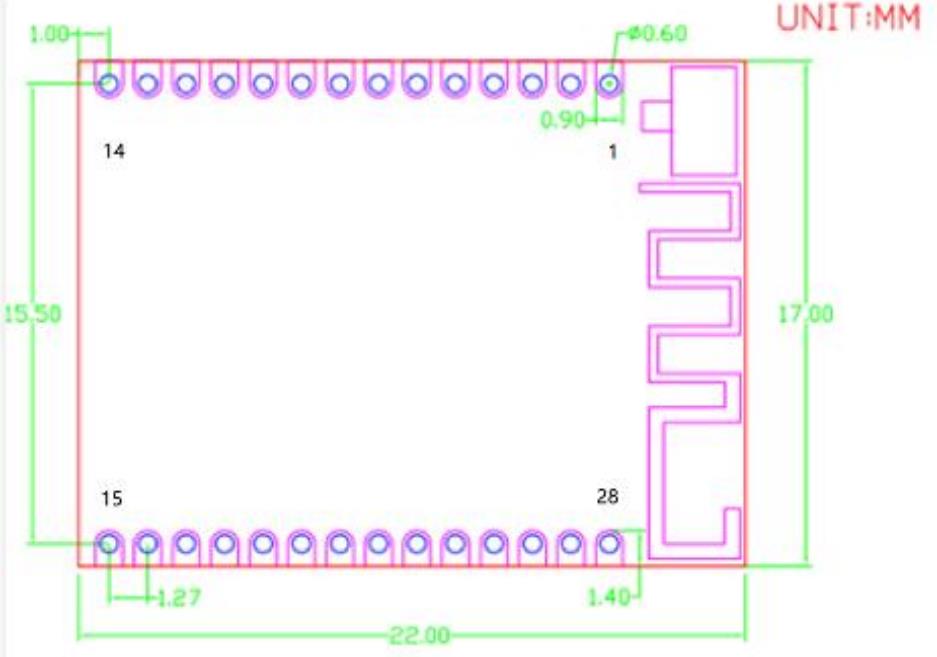
| Pin Number |
Symbol | IO Type | Function |
|---|---|---|---|
| 1 | GND | P | Power supply reference ground pin |
| 2 | ANT | RF | RF signal input/output port, which corresponds to ANT of IC |
| 3 | GND | P | Power supply reference ground pin |
| 4 | NC | Not connect | |
| 5 | PA0 | I/O | Corresponding to PA0 of IC |
| 6 | PC5 | I/O | Corresponding to PC5 of IC |
| 7 | PC4 | I/O | Corresponding to PC4 of IC |
| 8 | PA3 | I/O | Corresponding to PA3 of IC |
| 9 | PA4 | I/O | Corresponding to PA4 of IC |
| 10 | PC1 | I/O | Corresponding to PC1 of IC |
| 11 | PC0 | I/O | Corresponding to PC0 of IC |
| 12 | PD4 | I/O | Corresponding to PD4 of IC |
| 13 | PD3 | I/O | Corresponding to PD3 of IC |
| 14 | PD2 | I/O | Corresponding to PD2 of IC |
| 15 | NC | Not connect | |
| 16 | NC | Not connect | |
| 17 | PB0 | I/O | Corresponding to PB0 of IC |
| 18 | PB1 | I/O | Corresponding to PB1 of IC |
| 19 | NC | Not connect | |
| 20 | GND | P | Power supply reference ground pin |
| 21 | VCC | P | Power supply pin (3.3V) |
| 22 | RX0 | I | Corresponding to internal RXD0 of IC |
| 23 | TX0 | O | Corresponding to internal TXD0 of IC |
| 24 | SWDIO | I/O | Corresponding to internal SWDIO of IC |
| 25 | SWCLK | I/O | Corresponding to PF2 of IC |
| 26 | PC3 | I/O | Corresponding to PF3 of IC |
| 27 | PC2 | I/O | Not connect |
| 28 | nRESET | I | Hardware reset pin, which is at a high level by default and is active at a low level |
- P indicates power supply pins, I/O indicates input/output pins, and AI indicates analog input pins.
3. Electrical parameters of DSM-04B Zigbee/Matter/BLE Module
| Parameter | Description | Minimum | Maximum | Unit |
|---|---|---|---|---|
| Ts | Storage temperature | -50 | 125 | ℃ |
| VCC | Power supply voltage | 2 | 3.8 | V |
| Static electricity voltage (human body model) | TAMB-25℃ | - | 2 | KV |
| Static electricity voltage (machine model) | TAMB-25℃ | - | 0.5 | KV |
| Parameter Description | Description | Minimum | Typical | Maximum | Unit |
|---|---|---|---|---|---|
| Ta | Working temperature | -40 | -105 | - | ℃ |
| VCC | Power supply voltage | 2.0 | 3.0 | 3.8 | V |
| VIL | I/O low-level input | - | I0VDD*0.3 | V | |
| VIH | I/O high-level input | I0VDD*0.7 | - | - | V |
| VOL | I/O low-level output | - | I0VDD*0.2 | - | V |
| VOH | I/O high-level output | I0VDD*0.8 | - | - | V |
| Working status | Rate | TX Power/ Receiving | Typical | Maximum | Unit |
|---|---|---|---|---|---|
| TX | 250 Kbit/s | +20dBm | 200 | 206 | mA |
| TX | 250 Kbit/s | +10dBm | 62 | 64 | mA |
| TX | 250 Kbit/s | +0dBm | 26 | 28 | mA |
| RX | 250 Kbit/s | Constant receiving | 10 | 12 | mA |
| RX | 250 Kbit/s | Constant receiving | 10 | 12 | mA |
| RX | 250 Kbit/s | Constant receiving | 10 | 12 | mA |
| Working mode | Working status (Ta = 25℃) | Average | Maximum | Unit |
|---|---|---|---|---|
| EZ | The module is in EZ mode. | 10 | 40 | mA |
| Connected and idle | The module is connected to the network. | 4.2 | 5 | mA |
| Deep sleep mode | The module is in deep sleep mode, with 64 KB flash memory. | 5 | - | uA |
4. RF features of DSM-04B Zigbee/Matter/BLE Module
| Parameter | Description |
|---|---|
| Frequency band | 2.412~2.484GHz |
| Protocol standard | Zigbee 3.0/BLE 5.1/Matter |
| Data transmission rate | 250 Kbit/s |
| Antenna type | PCB antenna with a gain of 1dBi. IPEX (optional) |
| Parameter | Minimum | Typical | Maximum | Unit |
|---|---|---|---|---|
| Maximum output power(250Kbps) | - | 20 | - | dBm |
| Minimum output power(250Kbps) | - | -30 | - | dBm |
| Output power adjustment step | - | 0.5 | 1 | dBm |
| Output spectrum adjacent-channel rejection ratio | - | -31 | - | dBc |
| Frequency error | -15 | - | 15 | ppm |
| Parameter | Minimum | Typical | Maximum | Unit |
|---|---|---|---|---|
| PER<8%, RX sensitivity(250Kbps) | -102 | -101 | -99 | dBm |
5. Antenna of DSM-04B Zigbee/Matter/BLE Module
This product uses an onboard PCB antenna, whose gain is 1dBi
To ensure optimal RF performance, it is recommended that the antenna be at least 15 mm away from other metal parts. If metal materials are wrapped around the antenna, the wireless signals will be reduced greatly, deteriorating the RF performance.
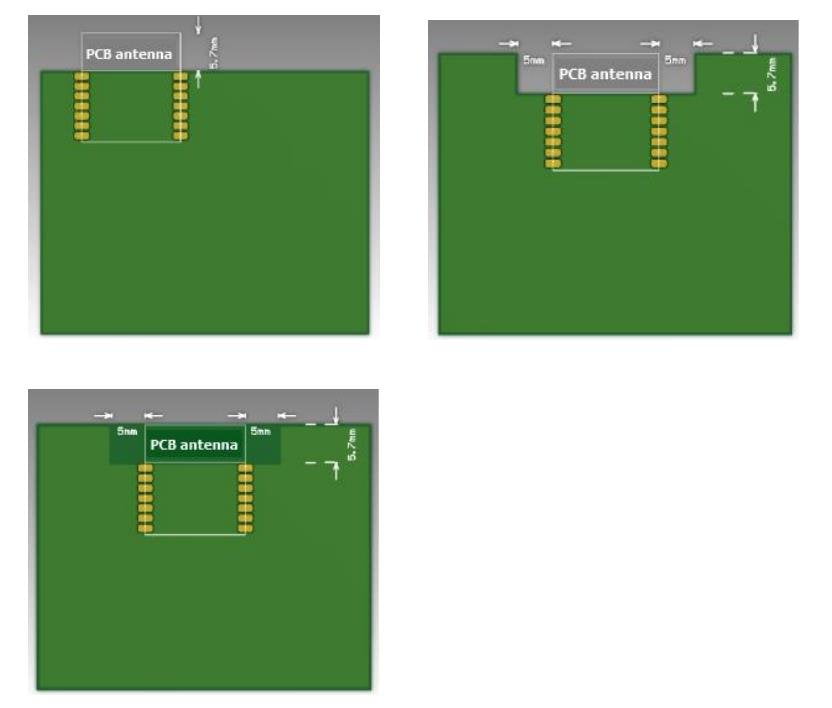
Do not place any metal in the red area above the antenna.
The recommended diameter of the circular arc is greater than 3cm.
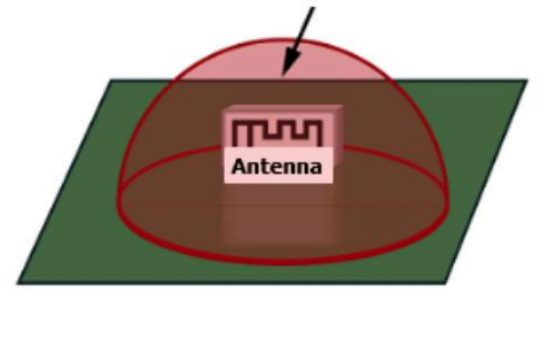
6. Production instructions of DSM-04B Zigbee/Matter/BLE Module
1. Use an SMT placement machine to mount components to the stamp hole module that Dusun produces within 24 hours after the module is unpacked and the firmware is burned. If not, vacuum packs the module again. Bake the module before mounting components to the module.
- SMT placement equipment:
Reflow soldering machine
Automated optical inspection (AOI) equipment
Nozzle with a 6 mm to 8 mm diameter - Baking equipment:
Cabinet oven
Anti-static heat-resistant trays
Anti-static heat-resistant gloves
2. Storage conditions for a delivered module are as follows:
- The moisture-proof bag is placed in an environment where the temperature is below 30℃ and the relative humidity is lower than 70%.
- The shelf life of a dry-packaged product is six months from the date when the product is
packaged and sealed. - The package contains a humidity indicator card (HIC).

3. Bake a module based on HIC status as follows when you unpack the module package:
- If the 30%, 40%, and 50% circles are blue, bake the module for 2 consecutive hours.
- If the 30% circle is pink, bake the module for 4 consecutive hours.
- If the 30% and 40% circles are pink, bake the module for 6 consecutive hours.
- If the 30%, 40%, and 50% circles are pink, bake the module for 12 consecutive hours.
4. Baking settings:
- Baking temperature: 125±5℃
- Alarm temperature: 130℃
- SMT placement ready temperature after natural cooling: < 36℃
- Number of drying times: 1
- Rebaking condition: The module is not soldered within 12 hours after baking.
5. Do not use SMT to process modules that have been unpacked for over three months. Electroless nickel immersion gold (ENIG) is used for the PCBs. If the solder pads are exposed to the air for over three months, they will be oxidized severely and dry joints or solder skips may occur. Dusun is not liable for such problems and consequences.
6. Before SMT placement, take electrostatic discharge (ESD) protective measures.
7. To reduce the reflow defect rate, draw 10% of the products for visual inspection and AOI before first SMT placement to determine a proper oven temperature and component placement method. Draw 5 to 10 modules every hour from subsequent batches for visual inspection and AOI.
7. Recommended oven temperature curve
Perform SMT placement based on the following reflow oven temperature curve. The highest temperature is 245℃.
Based on the IPC/JEDEC standard, perform reflow soldering on a module at most twice.
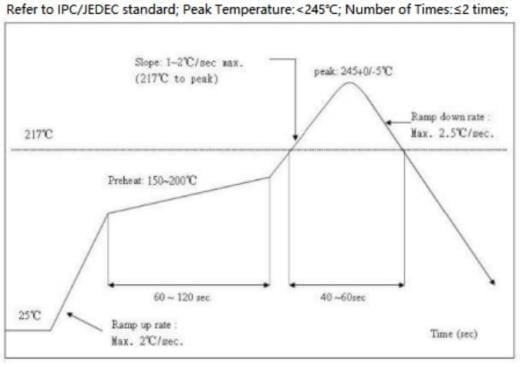
8. Storage conditions
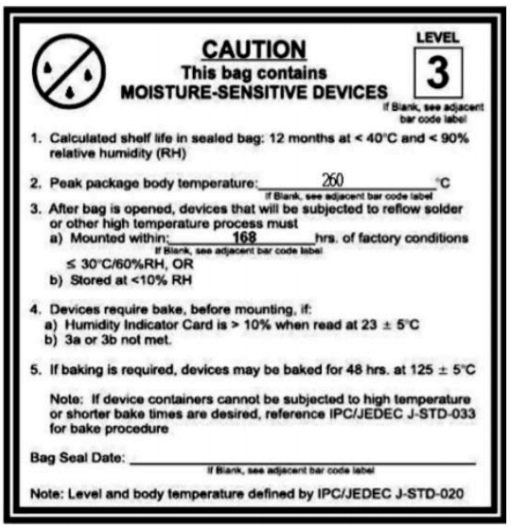
9. Ordering information

10. MOQ and packing
| Product model | MOQ(pcs) | Packing method | Number of Modules in each reel pack | Number of reel packs in each box |
|---|---|---|---|---|
| DSM-04B | 2800 | Carrier tape and reel packing | 700 | 4 |


















